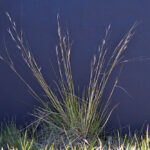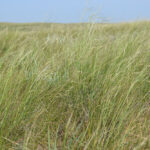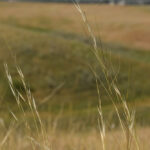Western Porcupine Grass
Hesperostipa curtiseta
General Description
Western porcupine grass is a mid-sized bunchgrass found on moister grasslands. Leaves are longer than needle-and-thread grass generally. Stems are 24-65 cm (11-30 in) tall. Seeds are sharp, with twicely bent awns (like a finger). Porcupine grass (Hesperostipa spartea), found commonly in Manitoba and Southeast Saskatchewan, is closely related with similar adaptability although a more robust plant adapted to higher moisture regimes and sub-irrigated sandy sites found there.
Type
Native grass.
Origin
Mixed grass prairie.
Longevity
Long-lived.
Use
Reclamation, pasture.
Optimal Time of Use
Graze western porcupine grass prior to seed set or later in the season after seed drop to avoid sharply awned seeds.
Recovery After Use
Requires a full growing season to recover from grazing.
Palatability/Nutritional Value
Western porcupine grass is a decreaser in rangelands and is palatable to livestock prior to seed set and after seed drop. Western porcupine grass has an average digestibility of 45% and crude protein of 6-10% in late summer.
Annual Precipitation min/max (mm)
Porcupine grass 350mm / 990mm. Western porcupine grass has an expected lower minimum tolerance.
Drought Tolerance
Good drought tolerance.
Flooding Tolerance
Tolerates saturated soils for approximately one week in the spring. Prefers moister sites.
Winter Hardiness
Good winter hardiness.
Soil Texture Preference
Western porcupine grass grows best on moist, fertile, loamy-clay soils.
Erosion Control
Western porcupine grass is effective in a reclamation mix if it can establish. It is deep rooted and anchors soil well.
Salinity Tolerance
Western porcupine grass is not recommended for saline areas.
Acidity Tolerance
Poor tolerance of acidic soils.
Alkalinity Tolerance
Unknown.
Seeds per kg
125,400 seeds/kg (57,000 seeds/lb)
Suggested Mixtures
Western porcupine grass is effective in native seed mixes, but seldom used due to limited seed availability for this species.
Ease of Establishment
Difficult.
Competitiveness
Western porcupine grass is a poor competitor.
Management Considerations
In a seeded native stand, include a legume with western porcupine grass to provide a nitrogen source. As a perennial bunchgrass it will not spread outwards in the stand.
Saskatchewan Dryland Forage Species Adaptation Tool, AAFC Field Guide to Selected Native Forages, USDA Plants Database
Porcupine grass is common and can be dominant in native grassland communites in the Bunchgrass and Interior Douglas-fir zones in the southern part of the Central Interior. It is not common in the other Central Interior zones.
Porcupine grass is common in native grassland communites in the Bunchgrass, Ponderosa Pine zones. It can be a dominant species in grasslands of the Interior Douglas-fir zone. It is infrequent or absent in the Interior Cedar-Hemlock zone.
Porcupine grass is found in native grassland communities in the Peace-Liard region, sometimes with slender wheatgrass, western wheatgrass and northern wheatgrass.


